Japan Data Center Server Market Size
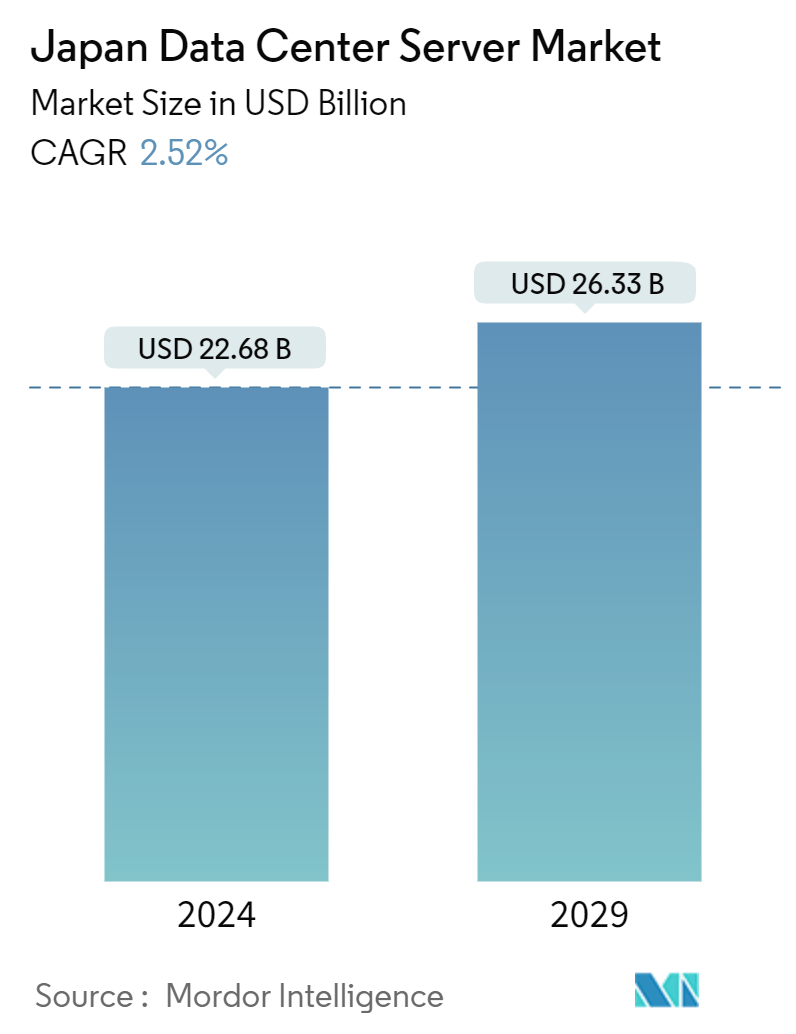
| Study Period | 2019 - 2030 |
| Base Year For Estimation | 2023 |
| Market Size (2024) | USD 22.68 Billion |
| Market Size (2030) | USD 26.33 Billion |
| CAGR (2024 - 2029) | 2.52 % |
| Market Concentration | Low |
Major Players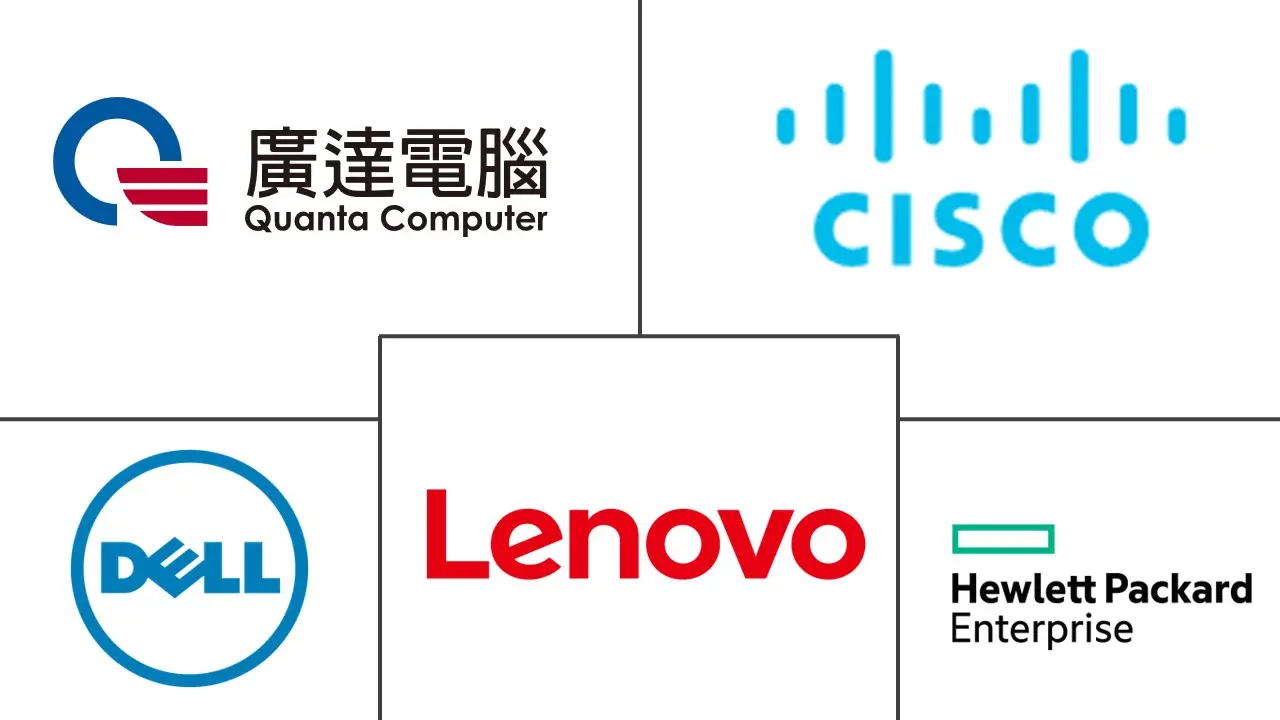
*Disclaimer: Major Players sorted in no particular order |
Japan Data Center Server Market Analysis
The Japan Data Center Server Market size is estimated at USD 22.68 billion in 2024, and is expected to reach USD 26.33 billion by 2030, growing at a CAGR of 2.52% during the forecast period (2024-2030).
Japan's demand for data centers is proliferating and becoming more attractive as a business market. Environmental initiatives, government support for local data centers, changes in industrial structure, and changing lifestyles due to technological advancements all play a significant role in the Japanese data center market, resulting in major demand for the server market.
- The major driver for the market growth is the growing demand for hyperscale construction in the Japanese region. Osaka's strength lies in its diverse concentration of industries, encompassing environmental, new energies, pharmaceuticals, and manufacturing sectors. This vibrant ecosystem fosters a unique coaction between hyperscale data centers and industries driving global sustainability and technological advancement. With a population of 8.8 million, Osaka Prefecture has a GDP of USD 360 billion, similar to the size of Norway's economy.
- Japan is widely regarded as one of the most advanced economies in terms of Internet penetration. As of 2023, Japan's Internet usage rate (individuals) was 82.9%, and the development rate of optical fiber was 99.3%. The number of broadband subscribers was 43.8 million, which includes 36.6 million FTTH subscribers and 6.5 million CATV Internet subscribers, while the number of mobile broadband subscribers (4G and 5G) was 184 million.
- The energy efficiency of cloud data centers can play a crucial role in reducing Japan's carbon footprint to achieve the Japanese government's goal of net-zero carbon emissions by 2050.
- Having recognized the benefits cloud technologies can provide to the country and their positive effect on encouraging innovation and fostering non-conventional business models, the Japanese government has been launching numerous initiatives to promote the cloud as part of the broader plans to digitalize the country further.
- To build a server, one must buy individual components first. They have to assemble the server and install the necessary software. It is resource-intensive to customize, own, and maintain a server. It is well-suited for long-term projects and knowledge-building within the company.
Japan Data Center Server Market Trends
Blade Server Form Factor Segment is Expected to Witness Significant Growth
- A blade server is a small computer used to host and distribute data within a network of computers and systems. It acts as a link between computers, applications, programs, and systems. According to Cloudscene, as of September 2023, there were 218 data centers in Japan. A blade server is typically used in larger data centers due to the need to maximize space and power utilization and efficiency, have high computing needs, and support higher thermal and electrical loads.
- There are close to 40 data centers in Japan that are identified as extensive data center facilities and are expected to increase in the coming years. The Japanese government plans to build several new data centers nationwide by decentralizing landing bases for submarine cables to diversify landing points. Submarine cables are laid mainly on Japan's eastern Pacific Ocean side, with many concentrated in certain areas, such as Tokyo and Shima. The government intends to disperse landing bases in other areas and strengthen economic security. This may lead to significant growth in the large DC segments in newer concentrated areas, boosting the demand for blade servers.
- Constraints on land and power in the greater Tokyo area result in higher construction costs, possible delays for new developments, and fierce competition from domestic and foreign players. DC construction companies are investing in new data centers to build new data centers on scarce land in Japan, but as the demand is high, these data centers are likely to have high computing power. The advantage of blade servers in this situation is that, due to the limited computing components of blade servers, customers can fit more servers into a smaller rack area to increase the density.
- Some Asian countries, such as Japan, do not support 110 V power infrastructure. As a result, they are unable to achieve the power density enjoyed in the United States. For example, a 3-phase 220V power data center in the United States can support a 15 kW rack. However, special cooling solutions are needed to support this power density. Blades are not a viable solution in cases where power is restricted to 110V, no matter the vendor. An exception to this would be a departmental solution, such as the HP BladeSystem C3000 or IBM BladeCenter S.
- Further, blade servers are designed for high-performance processing. Unlike rack servers, blade servers can be hot-swapped. This means that one can remove and replace a blade server in a cluster without powering down the whole cluster. This significantly reduces downtime when an administrator needs to swap out a blade server or move a blade server out of the cluster for maintenance.
- Understanding blade server technology's past, present, and future is essential for organizations of all sizes in Japan to make informed decisions regarding their IT infrastructure. Due to their compact design, high performance, and scalability, blade servers are expected to remain a key component of that infrastructure for many years as they continue to evolve and evolve with the ever-evolving world of technology.
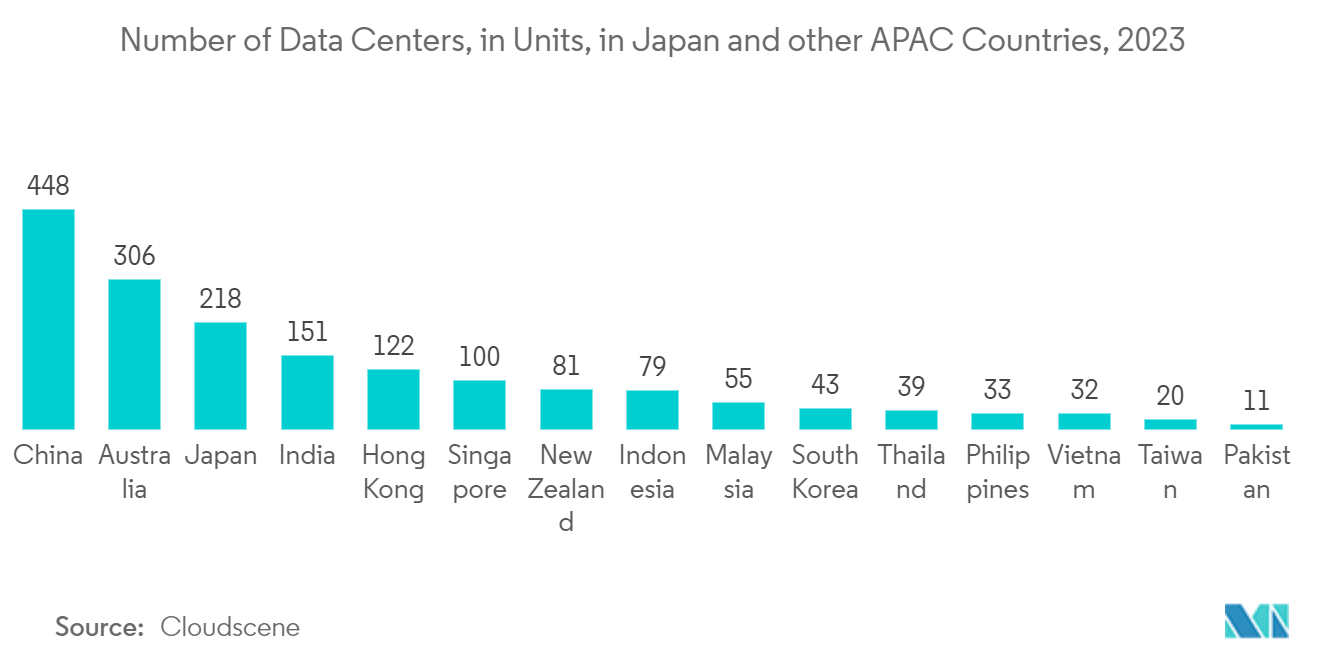
IT and Telecommunication to be the Fastest Growing End-user Industry
- Japan's Information and Communications Technology (ICT) sector is at the forefront of innovation, driving remarkable progress and creating a future-proof environment. The ICT sector opens up a world of possibilities by utilizing state-of-the-art technologies while facing the challenges that define its growth.
- The growth of the Japanese ICT market is mainly driven by the growing use of Internet of Things (IoT) devices across various sectors, such as consumer electronics, military, agriculture, and construction. Japan is home to some of the most prominent ICT organizations in the world, such as Sony, Panasonic, Fujitsu, NEC, and Toshiba (Toshiba), which are playing an important role in the growth of Japan as an ICT hub. The increasing government spending on maintaining the top-of-the-line and advanced infrastructure and the proper implementation of many modernization and improvement projects contribute to the market's expansion.
- Japan's ICT market is expected to grow due to the rapid expansion of E-Japan's strategy, which focuses on local e-government projects, such as citizen participation, self-assessment, and feedback on online government services.
- Japan has a high level of stability in business and society, as well as high-quality infrastructure and services such as ICT infrastructure, communication technology, education, healthcare, and more. The Japanese government is taking steps to support the private sector's digital transformation and the emergence of small and medium-sized enterprises (SMEs).
- Smart Cities are one of the Japanese government's key initiatives to bring Society 5.0 to life. The 6th Strategic Technology Infrastructure (STI) plan set a goal of 100 initiatives10 to be implemented by 2025 with the participation of 1000+ organizations from local government, regional organizations, and private enterprises. The "Smart City Public-Private Partnership platform" will replace the local and dispersed digital landscape to promote public-private partnerships and develop regional projects. Specific initiatives include centralizing the MyNumber (citizens ID) system and developing database registry standards by 2030.
- Further, the telecom companies in Japan are investing in 6G. The 6G system will not only outperform 5G, but it will also offer high speed, high capacity, low latency, new high-frequency bands (above 100 GHz), extend communication coverage to the sky, sea, and space, and provide ultra-low power consumption and ultra-low-cost communications. According to the Ministry of Internal Affairs and Communications, about 69.8 million 5G subscriptions were counted in Japan as of March 2023. In June 2022, NEC (NEC), Fujitsu (Fujitsu), and Nokia (Nokia) joined forces to test new mobile communication technologies to launch 6G services commercially by 2030.
- Thus, with the overall increase in investment by tech companies, government initiatives to improve the IT industry development and growth in data centers in the country would boost the server market in Japan.
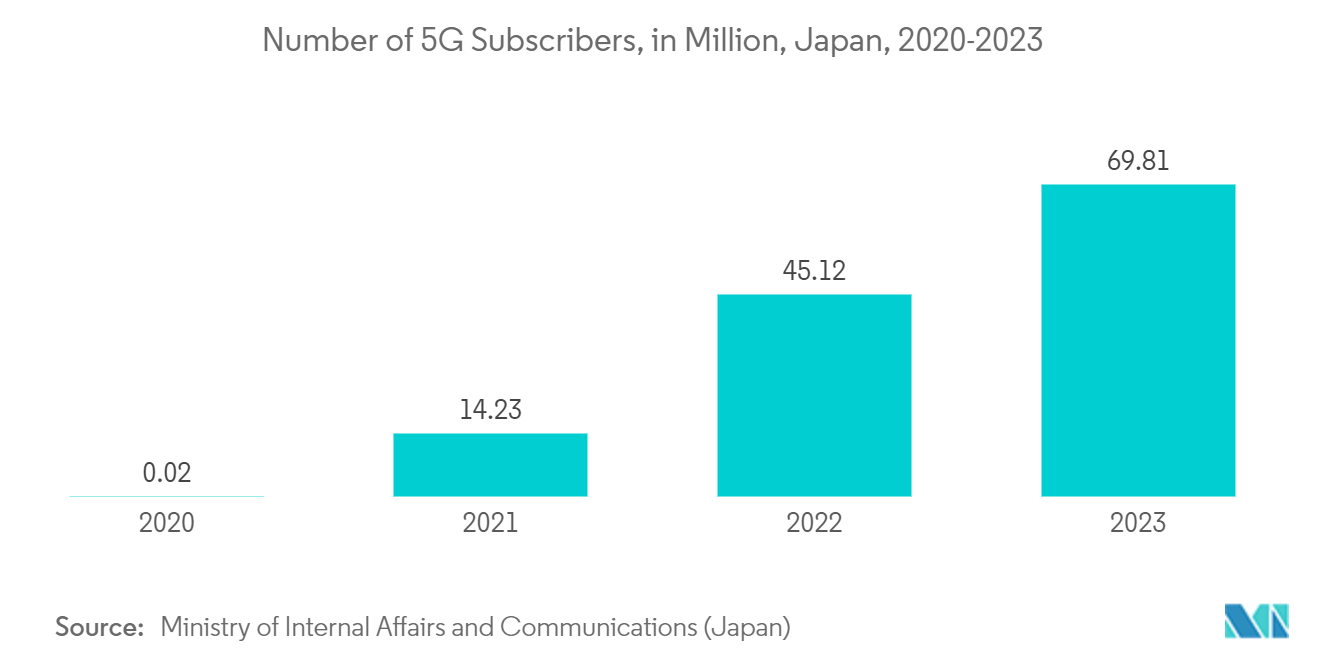
Japan Data Center Server Industry Overview
The Japan data center server market is highly fragmented with the presence of major players like Dell Technologies Inc., Hewlett Packard Enterprise, Cisco Systems Inc., Lenovo Group Limited, and Quanta Computer Inc. Players in the market are adopting strategies such as partnerships and acquisitions to enhance their product offerings and gain sustainable competitive advantage.
- December 2023 - Fujitsu announced the launch of a dedicated company for the hardware business in Japan in alignment with this strategy and to further strengthen the management of its hardware business, which primarily focuses on servers and storage solutions.
- August 2023 - Hewlett Packard Enterprise announced that phoenixNAP is expanding its Bare Metal Cloud platform with cloud-native HPE ProLiant RL300 Gen11 servers, using energy-efficient processors from Ampere Computing. The expanded services support AI inferencing, cloud gaming, and other cloud-native workloads with enhanced performance and energy efficiency.
- July 2023 - Fujitsu announced a new server, BS2000 SE730/SE730B. The servers of the latest SE generation are a valued platform in the high-end performance range for managing the largest data volumes. The servers offer extremely high availability and serve as an ideal platform for mission-critical applications.
Japan Data Center Server Market Leaders
-
Dell Technologies Inc.
-
Hewlett Packard Enterprise
-
Cisco Systems Inc.
-
Lenovo Group Limited
-
Quanta Computer Inc.
*Disclaimer: Major Players sorted in no particular order
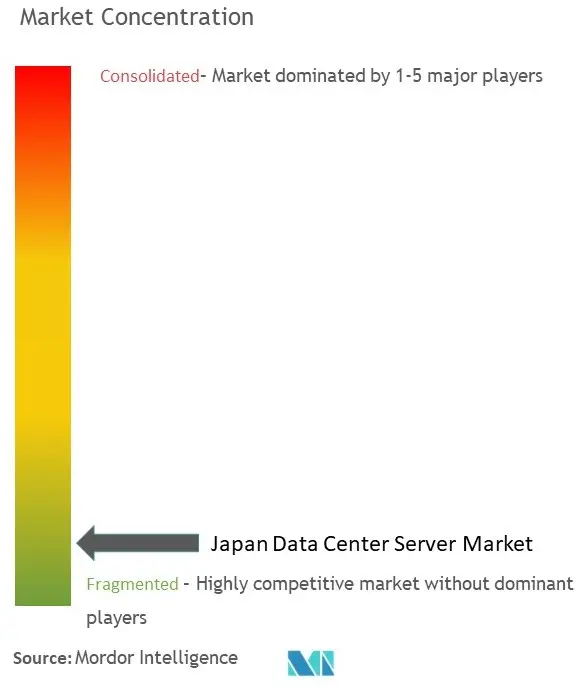
Japan Data Center Server Market News
- February 2024 - Marubeni Corporation and Yondr Group entered a joint venture to develop data center facilities in Japan. Initially, Marubeni will construct a data center facility in the West Tokyo area, with further projects planned in the future. The project will initiate Marubeni's expansion into the emerging hyper-scale data center development market and its ambition to contribute to the decarbonization of society by supplying renewable energy to data centers.
- October 2023 - Air Trunk announced a significant expansion in Japan by launching a new data center in Osaka. The facility, OSK1, marks AirTrunk's third data center in Japan and its first venture outside the Tokyo region. OSK1 is set to offer more than 20 megawatts (MW) capacity, contributing to the regional diversity in a new major availability zone.
Japan Data Center Server Market Report - Table of Contents
1. INTRODUCTION
- 1.1 Study Assumption and Market Definition
- 1.2 Scope of the Study
2. RESEARCH METHODOLOGY
3. EXECUTIVE SUMMARY
4. MARKET INSIGHTS
- 4.1 Market Overview
-
4.2 Industry Attractiveness - Porter's Five Forces Analysis
- 4.2.1 Bargaining Power of Suppliers
- 4.2.2 Bargaining Power of Buyers
- 4.2.3 Threat of New Entrants
- 4.2.4 Threat of Substitute Products
- 4.2.5 Intensity of Competitive Rivalry
- 4.3 Industry Value Chain Analysis
5. MARKET DYNAMICS
-
5.1 Market Drivers
- 5.1.1 Increase in Construction of New Data Centers, Development of Internet Infrastructure
- 5.1.2 Increasing Adoption of Cloud and IoT Services
-
5.2 Market Challenge
- 5.2.1 High Initial Investments
- 5.3 Assessment of COVID-19 Impact
6. MARKET SEGMENTATION
-
6.1 By Form Factor
- 6.1.1 Blade Server
- 6.1.2 Rack Server
- 6.1.3 Tower Server
-
6.2 By End User
- 6.2.1 IT and Telecommunication
- 6.2.2 BFSI
- 6.2.3 Government
- 6.2.4 Media and Entertainment
- 6.2.5 Other End Users
7. COMPETITIVE LANDSCAPE
-
7.1 Company Profiles*
- 7.1.1 Dell Technologies Inc.
- 7.1.2 Hewlett Packard Enterprise
- 7.1.3 Cisco Systems Inc.
- 7.1.4 Lenovo Group Limited
- 7.1.5 Quanta Computer Inc.
- 7.1.6 Super Micro Computer Inc.
- 7.1.7 Huawei Technologies Co. Ltd
- 7.1.8 Fujitsu Limited
- 7.1.9 NEC Corporation
- 7.1.10 IBM Corporation
8. INVESTMENT ANALYSIS
9. MARKET OPPORTUNITIES AND FUTURE TRENDS
** Subject To AvailablityJapan Data Center Server Industry Segmentation
The Japan data center server market is defined by the revenue accrued from various solutions used across end-user industries.
The Japan data center server market is segmented by form factor (blade server, rack server, and tower server) by end user (IT and telecommunication, BFSI, government, media and entertainment, and other end users). The market sizes and forecasts are provided in terms of value (USD) for all the above segments.
| By Form Factor | Blade Server |
| Rack Server | |
| Tower Server | |
| By End User | IT and Telecommunication |
| BFSI | |
| Government | |
| Media and Entertainment | |
| Other End Users |
Japan Data Center Server Market Research FAQs
How big is the Japan Data Center Server Market?
The Japan Data Center Server Market size is expected to reach USD 22.68 billion in 2024 and grow at a CAGR of 2.52% to reach USD 26.33 billion by 2030.
What is the current Japan Data Center Server Market size?
In 2024, the Japan Data Center Server Market size is expected to reach USD 22.68 billion.
Who are the key players in Japan Data Center Server Market?
Dell Technologies Inc., Hewlett Packard Enterprise, Cisco Systems Inc., Lenovo Group Limited and Quanta Computer Inc. are the major companies operating in the Japan Data Center Server Market.
What years does this Japan Data Center Server Market cover, and what was the market size in 2023?
In 2023, the Japan Data Center Server Market size was estimated at USD 22.11 billion. The report covers the Japan Data Center Server Market historical market size for years: 2019, 2020, 2021, 2022 and 2023. The report also forecasts the Japan Data Center Server Market size for years: 2024, 2025, 2026, 2027, 2028, 2029 and 2030.
Japan Data Center Server Industry Report
Statistics for the 2024 Japan Data Center Server market share, size and revenue growth rate, created by Mordor Intelligence™ Industry Reports. Japan Data Center Server analysis includes a market forecast outlook to for 2024 to 2030 and historical overview. Get a sample of this industry analysis as a free report PDF download.



